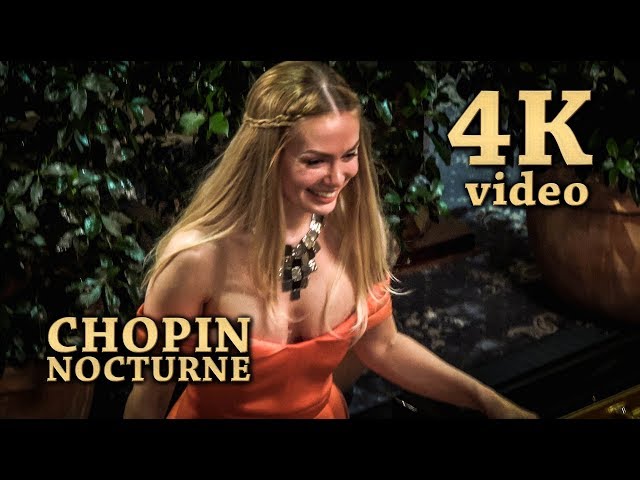Tags
Aucun mot clé
Chopin Nocturne Op 9 No 2 Anastasia Huppmann
Chopin Nocturne Op 9 No 2 recorded and played by Anastasia Huppmann in Steyr, Austria.
Visite: http://www.anastasiahuppmann.com
facebook: https://www.facebook.com/huppmannanastasia
twitter: https://twitter.com/anahuppmann
instagram: https://www.instagram.com/anastasia_huppmann
❤️ https://www.buymeacoffee.com/anastasiahuppmann ❤️
Chopin composed his best-known Nocturne Op 9 No 2 when he was around twenty years old.
This well-known nocturne is in rounded binary form (A, A, B, A, B, A) with coda, C. The A and B sections become increasingly ornamented with each recurrence. The penultimate bar utilizes considerable rhythmic freedom, indicated by the instruction, senza tempo (without tempo). Nocturne in E-flat major opens with a legato melody, mostly played piano, containing graceful upward leaps which becomes increasingly wide as the line unfolds. This melody is heard again three times during the piece. With each repetition, it is varied by ever more elaborate decorative tones and trills. The Chopin Nocturne Op 9 No 2 also includes a subordinate melody, which is played with rubato.
In the late memoirs of the interesting and mysterious figure Wilhelm von Lenz, a pupil of Liszt (then of Chopin) and an eminent music writer (author of an important study of Beethoven), one comes across an amusing, but thought-provoking story concerning this Nocturne. Lenz recalls the times when he took lessons from Chopin. ‘I tormented Chopin most’, he relates, ‘with the famous Nocturne in E flat major, Op. 9 […] in 1842 it was in the full bloom of fashion […] When Chopin was pleased with a scholar, he, with a small, well-sharpened pencil, made a cross under the composition. I had received one, in the Nocturne (premier chevron); next time I came, I got another. I came still another time. “Do please let me alone,” said Chopin […] there, you have another cross, more than three I never give. You cannot do it any better!” “You play it so beautifully,” I ventured, “can no one else?” “Liszt can,” said Chopin, drily, and played it to me no more. He had noted in it some very important little changes for me; his notes were clean, small, and sharp.
The Chopin Nocturne Op 9 No 2 was recorded in Austria. All rights (Audio and Video) belongs to Anastasia Huppmann.
Visite: http://www.anastasiahuppmann.com
facebook: https://www.facebook.com/huppmannanastasia
twitter: https://twitter.com/anahuppmann
instagram: https://www.instagram.com/anastasia_huppmann
❤️ https://www.buymeacoffee.com/anastasiahuppmann ❤️
Chopin composed his best-known Nocturne Op 9 No 2 when he was around twenty years old.
This well-known nocturne is in rounded binary form (A, A, B, A, B, A) with coda, C. The A and B sections become increasingly ornamented with each recurrence. The penultimate bar utilizes considerable rhythmic freedom, indicated by the instruction, senza tempo (without tempo). Nocturne in E-flat major opens with a legato melody, mostly played piano, containing graceful upward leaps which becomes increasingly wide as the line unfolds. This melody is heard again three times during the piece. With each repetition, it is varied by ever more elaborate decorative tones and trills. The Chopin Nocturne Op 9 No 2 also includes a subordinate melody, which is played with rubato.
In the late memoirs of the interesting and mysterious figure Wilhelm von Lenz, a pupil of Liszt (then of Chopin) and an eminent music writer (author of an important study of Beethoven), one comes across an amusing, but thought-provoking story concerning this Nocturne. Lenz recalls the times when he took lessons from Chopin. ‘I tormented Chopin most’, he relates, ‘with the famous Nocturne in E flat major, Op. 9 […] in 1842 it was in the full bloom of fashion […] When Chopin was pleased with a scholar, he, with a small, well-sharpened pencil, made a cross under the composition. I had received one, in the Nocturne (premier chevron); next time I came, I got another. I came still another time. “Do please let me alone,” said Chopin […] there, you have another cross, more than three I never give. You cannot do it any better!” “You play it so beautifully,” I ventured, “can no one else?” “Liszt can,” said Chopin, drily, and played it to me no more. He had noted in it some very important little changes for me; his notes were clean, small, and sharp.
The Chopin Nocturne Op 9 No 2 was recorded in Austria. All rights (Audio and Video) belongs to Anastasia Huppmann.
Comments (0)
